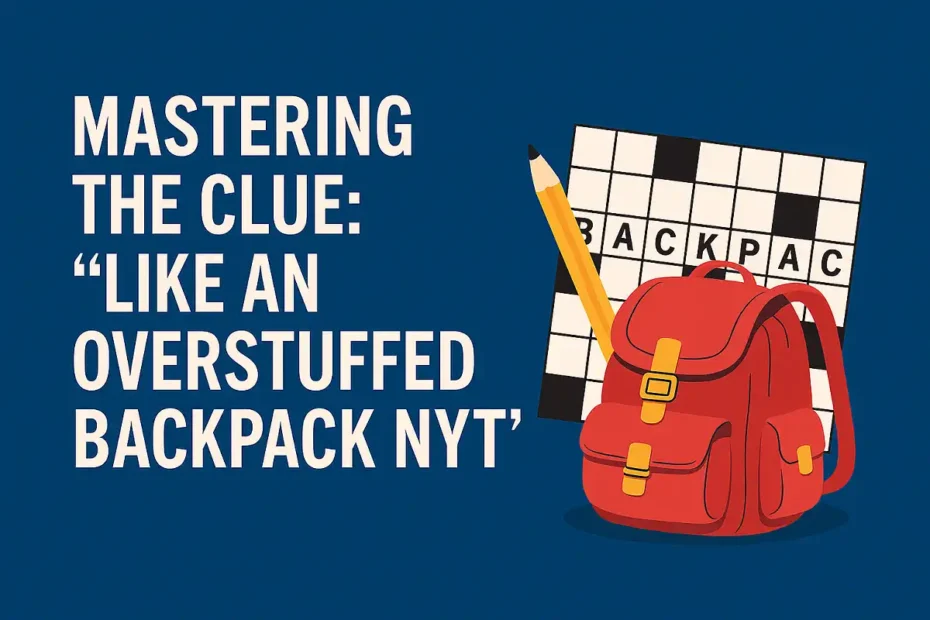The realm of crossword puzzles is filled with intriguing, challenging clues that compel solvers to think creatively and expansively. One vivid example is the clue “like an overstuffed backpack nyt,” which recently appeared in The New York Times Mini Crossword. This specific clue paints a compelling visual image and tests the solver’s ability to connect descriptive terms to real-world scenarios. In this article, we’ll explore this clue thoroughly, examining why such clues appeal to puzzle enthusiasts and how to solve descriptive crossword clues effectively.
Understanding Like an Overstuffed Backpack NYT
The clue “like an overstuffed backpack nyt” appeared in The New York Times Mini Crossword on February 1, 2024. The answer to this visually evocative clue is “bulgy,” referring to something swollen or protruding due to excessive contents. The term effectively captures the visual essence of an overfilled backpack, which typically bulges with books, clothes, and various items, stretching the seams to their limits.
The choice of the adjective “bulgy” illustrates the crossword creators’ skill in selecting words that evoke clear images in solvers’ minds. Such clues resonate with solvers because they invoke familiar experiences—nearly everyone has encountered an overstuffed backpack at some point, whether while packing for school, hiking trips, or traveling.
The Power of Vivid Imagery in Crossword Puzzles
Crossword puzzles often rely on vivid imagery to engage and challenge their audience. Clues like “like an overstuffed backpack nyt” succeed because they tap into the solver’s imagination, prompting visual recall that aids in word identification. The image of an overstuffed backpack immediately conjures a sense of excess, strain, and fullness, guiding solvers toward adjectives that encapsulate those characteristics.
The effectiveness of this clue lies in its universal relatability. Solvers instinctively visualize the scenario described, aiding them in connecting the image to the word “bulgy.” Imagery-based clues thus serve a dual purpose: they make puzzles entertaining and enhance cognitive associations between words and visual representations.
Contextual Importance in Solving Crossword Clues
In crossword solving, context plays an essential role in decoding clues. Knowing the source, such as The New York Times Mini Crossword, provides critical insight into the clue’s complexity and style. The Mini Crossword is popular for its brevity, precision, and approachability, making the clue “like an overstuffed backpack nyt” ideal for its format.
Understanding context helps solvers narrow down potential answers. The Mini Crossword typically requires concise, straightforward solutions, pushing solvers to consider shorter, vivid adjectives like “bulgy,” rather than longer or overly technical terms.
Enhancing Vocabulary through Crossword Puzzles
Participating regularly in crossword puzzles like those found in The New York Times Mini Crossword significantly enhances one’s vocabulary. Clues such as “like an overstuffed backpack nyt” introduce solvers to descriptive terms that might not frequently appear in casual conversation. Words like “bulgy” are descriptive, colorful, and expand one’s expressive abilities.
Encountering such unique adjectives in puzzle-solving contexts allows for better retention and deeper understanding of vocabulary usage. Consequently, regular crossword solving is widely recommended as a cognitive exercise that strengthens language proficiency.
The Popularity of The New York Times Mini Crossword
The New York Times Mini Crossword enjoys widespread popularity for its concise yet challenging puzzles. The inclusion of imaginative clues like “like an overstuffed backpack nyt” demonstrates the puzzle creators’ commitment to engaging their audience through creativity and relatable scenarios.
The format of the Mini Crossword—short and accessible—encourages daily participation, fostering a habitual interaction that continually tests and refines solvers’ linguistic and cognitive skills.
Effective Strategies for Tackling Descriptive Clues
When solving vivid, imagery-driven clues like “like an overstuffed backpack nyt,” several effective strategies can help solvers arrive at the correct answer:
1. Visualization
Imagine the scenario described by the clue. Visualizing an overstuffed backpack immediately suggests adjectives related to swelling, bulging, or overflowing.
2. Synonym Exploration
Think of synonyms or words closely related to the descriptive imagery. Terms like “bulgy,” “bloated,” or “stuffed” often emerge naturally from mental imagery.
3. Letter Count Awareness
Use the puzzle’s format to your advantage by counting the squares available for the answer. This helps quickly eliminate unsuitable synonyms, guiding you directly to the correct term.
4. Common Usage Reflection
Consider how the described scenario might commonly appear in everyday language. An overstuffed backpack evokes a casual, everyday scenario, steering solvers toward simpler, more commonly understood adjectives.
By adopting these strategies, solvers can efficiently navigate even the most vividly descriptive crossword clues.
Conclusion
The clue “like an overstuffed backpack nyt” exemplifies how crossword puzzles employ vivid, relatable imagery to create engaging and mentally stimulating challenges. This clue, characteristic of The New York Times Mini Crossword, captures solvers’ attention by invoking familiar visuals, ultimately guiding them to the descriptive answer, “bulgy.”
Engaging with such clues not only enhances linguistic skills and vocabulary but also sharpens cognitive abilities through regular practice. The enduring appeal of crossword puzzles, particularly the accessible yet challenging Mini Crossword, lies in their unique combination of creative imagery and intellectual rigor.
Whether you’re a seasoned crossword enthusiast or a casual solver, vividly descriptive clues like “like an overstuffed backpack nyt” remind us of the joy found in the playful intersection of language, imagery, and intellect.
For more informational articles, please visit: NYT Updares
